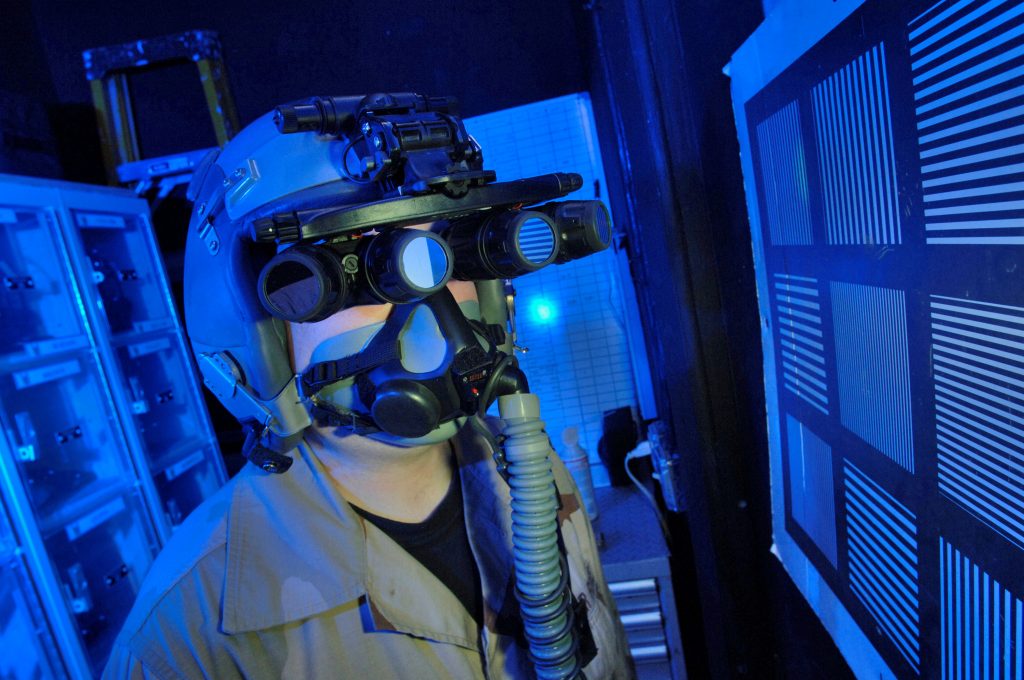 U.S.A.F. photo
U.S.A.F. photo Where does wearable technology exist? The question is more complex than it might first appear, when one considers the thin corpus of metaphors that are available to us to describe the Internet and technology. Do wearables exist somewhere between the physical and the virtual worlds? When you use them, are they like a pencil or are they like your body? In terms of regulation, are they like an iPhone, a house, or a limb? Can they be compared to prosthetics? What kind of conceptual domain are we working with?
Do wearables exist somewhere between the physical and the virtual worlds?
The metaphors we use matter because metaphors carry weight. “Metaphors are encumbered with assumptions,” says a recent Atlantic article, “and when people use metaphors, they embed those assumptions in the discussion. These assumptions are the residue of the physical analogues from which the metaphors draw.” One of the most widely accepted metaphors for describing the virtual reality of the online world is the concept of cyberspace, described in William Gibson’s 1984 sci-fi novel Neuromancer [4] this way: “Lines of light ranged in the nonspace of the mind, clusters and constellations of data. Like city lights, receding.” Cyberspace exists outside of the realm of the real, according to Gibson. It is a “nonspace” that simultaneously possesses spatial contours and yet doesn’t.
Gibson’s description of cyberspace neatly halves the digital and the physical worlds, a concept referred to as “digital dualism.” We should exercise caution in our embrace of the digital dualism embodied in the term “cyberspace,” argues David Meyer [9]. Cyberspace “denotes a place but, if anything, it’s about the elimination of spatial concerns as we socialize, collaborate and work together across the world.” When we allow ourselves to split the world into two halves – the digital and the real – we fail to acknowledge all the ways in which those two worlds are simultaneously constructing and co-constructing one another.
The kinds of comparisons we make when we talk about technology have huge implications for how we regulate and value wearable technologies and, by association, the human body. Jawbone and Fitbit are recent examples of “lifestyle tracking systems” that consist of a wearable bracelet that communicates with an iPhone app to log a user’s physical activity. As these products began flooding the market in 2011, journalists and technologists struggled to talk about wearbles without relying on the same kinds of man-as-a-machine metaphors that we’ve been using for centuries: Your body needs tuning and fueling. Your health is a number that can be quantified, analyzed, and improved. The words we use to describe wearables reduce the body to a “quantified self” dashboard, resulting in the depersonalization of data collection. The human body and embodied reality is removed from the equation.
The man/machine comparison is not unique to modern-day conversations about technology. Reframing the way we think about automata, Rene Descartes in 1641 advanced the concept of mind-body dualism, which asserts that the mind and the body are ontologically distinct substances. He suggested that our bodies are no more than complex machines and as such, our bones and organs could be replaced by cogs its, is the seat of intelligence and consciousness; the mind exists in the realm of the immaterial and the body exists in the realm of the material.
In Discipline and Punish, Michel Foucault [2] responds to the man-as-a-machine question, suggesting that Cartesian ideas constitute “a materialist reduction of the soul” at the center of which is the notion of “docility.” While the man-as-amachine metaphor might serve as a useful heuristic, it also reduces the body to something that is defunct, waiting for commands from the brain before springing into action.
Recent developments in neuroscience support a rejection of Cartesian dualism, providing evidence that the brain and the body are, in fact, co-dependent. Our “higher” thoughts depend on our “lower” body/bodily functions. If that is the case, then popular theories in artificial intelligence that advocate “uploading” our consciousness onto a hard drive would prove misguided, since we can’t comprehend existence without embodiment.
This Cartesian framework for thinking about human consciousness has persisted and continues to shape the way in which our bodies interact with technology. In How We Became Posthumen, Katherine Hayles [7] argues that modern ideas about artificial intelligence have given rise to dangerous fantasies of disembodiment. “If my nightmare is a culture inhabited by posthumans who regard their bodies as accessories rather than the ground of being,” she writes, “my dream is a version of the posthuman that embraces the possibilities of information technologies without being seduced by fantasies of unlimited power and disembodied immortality.”
The dualism we are trying to overcome is embedded in the metaphors we use. Thought grows out of our bodily experience, and yet so many conversations about artificial intelligence are centered on cognition as a distinct experience from embodiment. One could argue that this de-valuing of the body has helped fuel a curious obsession with self-mastery. The “quantified self” trend that is exemplified in wearable technology feeds into a broader industry movement towards tools that encourage self-mastery over the body. By talking about our bodies as empty vessels, we subscribe to dangerous fantasies of complete power over the body.
Metaphors matter because they carry baggage. When we elevate consciousness above the body in terms of importance, we begin to view our bodies as prosthetic limbs, empty shells waiting for orders from the brain. We fail to acknowledge the ways that our bodies are mediating our reality.
Author
Rebecca Ricks is a master’s degree candidate at the Tisch School of the Arts’ Interactive Telecommunications Program (ITP) at New York University, New York, NY. Email: baricks@gmail.com.







 JOIN SSIT
JOIN SSIT